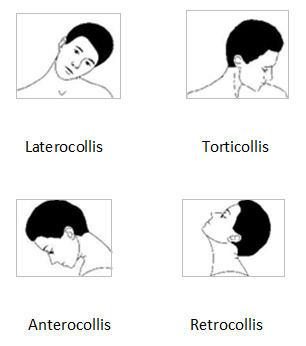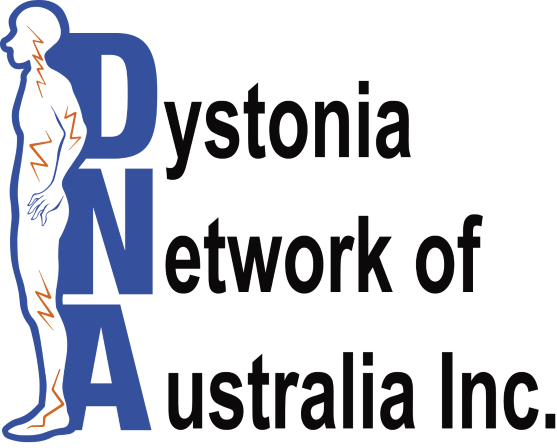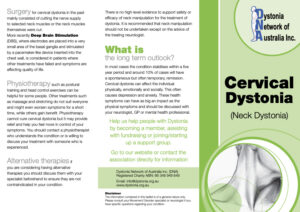What is cervical dystonia?
Cervical dystonia (CD), also known as spasmodic torticollis or neck dystonia, is a focal dystonia which means it affects only one area of the body, in this case the neck muscles. It can cause involuntary, abnormal postures, tremor and painful muscular spasms. There are four main types of cervical dystonia (see diagram below):

People with cervical dystonia may have more than one form. Symptoms vary greatly from person to person and so disability can range from mild to severe. More females than males have cervical dystonia and symptoms can appear at any age but it is more common between 40 and 60 years of age.
What causes cervical dystonia?
For most people no cause is found. However, it is generally accepted that cervical dystonia is related to a problem with the functioning and connections of various areas of the brain including the basal ganglia and cerebellum. There is no known cure but there are treatments that help with the symptoms. Some genes have been found in families and more research is being carried out in this area.
Acquired or secondary cervical dystonia can occur due to trauma, stroke, a reaction to certain drugs or other neurological conditions.
How is cervical dystonia diagnosed?
Diagnosis is based on the clinical judgement of a neurologist with a special interest or expertise in Movement Disorders after consideration and evaluation of the clinical symptoms, physical examination and detailed history. There are no special scans, XRAYs or blood tests in diagnosis but these investigations can exclude other conditions.
Some people with cervical dystonia can help their dystonia by a so-called “sensory trick”. They notice that touching their head or face in a particular spot temporarily improves the abnormal positioning of the neck.
What treatments are available?
Please see treatment options for more information on these treatments.
Oral medications include benzodiazepines, antispasmodics, anticholinergics and in some cases drugs used for Parkinson’s disease. These medications have varying and limited success in managing symptoms.
Botulinum toxin remains the treatment of choice at present for most people with cervical dystonia. The neck muscles that are overactive and responsible for the abnormal posture or tremor of the neck are injected. This treatment reduces the overactivity of the muscles by weakening them. Often the injecting neurologist will be guided by recording the activity within the muscle before injecting. This is called electromyography, or EMG. Botulinum toxin has been used successfully and safely worldwide for many years and has the most success in reducing symptoms, particularly pain. Most people tolerate this treatment but potential side effects must be considered.
Surgery for cervical dystonia in the past mainly consisted of cutting the nerve supply to selected neck muscles or the neck muscles themselves were cut.
More recently Deep Brain Stimulation (DBS), where electrodes are placed into a very small area of the basal ganglia and stimulated by a pacemaker-like device inserted into the chest wall, is considered in patients where other treatments have failed and symptoms are affecting quality of life.
Physiotherapy such as postural training and head control exercises can be helpful for some people. Other treatments such as massage and stretching do not suit everyone and might even worsen symptoms for a short time, while others gain benefit. Physiotherapy cannot cure cervical dystonia but it may provide relief and help you feel more in control of your symptoms. You should contact a physiotherapist who understands the condition or is willing to discuss your treatment with someone who is experienced.
Alternative therapies: if you are considering having alternative therapies you should discuss them with your specialist beforehand to ensure they are not contraindicated in your condition. There is no high level evidence to support safety or efficacy of neck manipulation for the treatment of dystonia. It is recommended that neck manipulation should not be undertaken except on the advice of the treating neurologist.
What is the long term outlook?
In most cases the condition stabilises within a five year period and around 10% of cases will have a spontaneous but often temporary, remission. Cervical dystonia can affect the individual physically, emotionally and socially. This often causes depression and anxiety. These health symptoms can have as big an impact as the physical symptoms and should be discussed with your neurologist, GP or mental health professional.
Download Brochure
Brochure – Cervical Dystonia
Download PDF
Not a member? Join today to assist us to continue to provide resources.
Disclaimer: The information contained on this page is of a general nature only. Please consult a Movement Disorders specialist or neurologist if you have specific questions regarding your condition.
Page reviewed 31 January 2024





